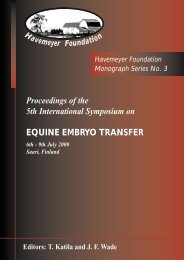Proceedings of a Workshop on - The Havemeyer Foundation
Proceedings of a Workshop on - The Havemeyer Foundation
Proceedings of a Workshop on - The Havemeyer Foundation
You also want an ePaper? Increase the reach of your titles
YUMPU automatically turns print PDFs into web optimized ePapers that Google loves.
Equine Recurrent Laryngeal Neuropathy<br />
TABLE 2: Grading system <str<strong>on</strong>g>of</str<strong>on</strong>g> laryngeal functi<strong>on</strong> performed in the standing unsedated horse †<br />
Grade Descripti<strong>on</strong> Sub-grade<br />
I<br />
All arytenoid cartilage movements<br />
are synchr<strong>on</strong>ous and symmetrical and<br />
full arytenoid cartilage abducti<strong>on</strong> can<br />
be achieved and maintained<br />
II Arytenoid cartilage movements are .1 Transient asynchr<strong>on</strong>y, flutter or delayed<br />
asynchr<strong>on</strong>ous and/or larynx asymmetric movements are seen<br />
at times but full arytenoid cartilage .2 <strong>The</strong>re is asymmetry <str<strong>on</strong>g>of</str<strong>on</strong>g> the rima glottidis<br />
abducti<strong>on</strong> can be achieved and<br />
maintained<br />
much <str<strong>on</strong>g>of</str<strong>on</strong>g> the time due to reduced mobility<br />
<str<strong>on</strong>g>of</str<strong>on</strong>g> the affected arytenoid and vocal fold but<br />
there are occasi<strong>on</strong>s, typically after<br />
swallowing or nasal occlusi<strong>on</strong> when full<br />
symmetrical abducti<strong>on</strong> is achieved and<br />
maintained<br />
III Arytenoid cartilage movements are .1 <strong>The</strong>re is asymmetry <str<strong>on</strong>g>of</str<strong>on</strong>g> the rima glottidis<br />
asynchr<strong>on</strong>ous and/or asymmetric. much <str<strong>on</strong>g>of</str<strong>on</strong>g> the time due to reduced mobility <str<strong>on</strong>g>of</str<strong>on</strong>g><br />
Full arytenoid cartilage abducti<strong>on</strong> the arytenoid and vocal fold but there are<br />
cannot be achieved and<br />
occasi<strong>on</strong>s, typically after swallowing or nasal<br />
maintained<br />
occlusi<strong>on</strong> when full symmetrical abducti<strong>on</strong> is<br />
achieved but not maintained<br />
.2 Obvious arytenoid abductor deficit and<br />
arytenoid asymmetry. Full abducti<strong>on</strong> is never<br />
achieved<br />
.3 Marked but not total arytenoid abductor<br />
deficit and asymmetry with little arytenoid<br />
movement. Full abducti<strong>on</strong> is never achieved<br />
IV<br />
Complete immobility <str<strong>on</strong>g>of</str<strong>on</strong>g> the arytenoid<br />
cartilage and vocal fold<br />
† Descripti<strong>on</strong> generally refers to the left arytenoid cartilage in reference to the right. However this grading<br />
system can apply to the right side (ie right Grade III-1)<br />
6. Following ventriculo-cordectomy abnormal<br />
upper airway sounds can c<strong>on</strong>tinue to decrease<br />
for up to 90 days after surgery.<br />
7. Bilateral ventriculo-cordectomy is superior to<br />
laryngoplasty al<strong>on</strong>e in reducti<strong>on</strong> <str<strong>on</strong>g>of</str<strong>on</strong>g> abnormal<br />
sounds in horses with experimentally induced<br />
left laryngeal hemiplegia.<br />
Exercise intolerance<br />
1. Unilateral ventriculectomy is ineffective in<br />
restoring normal airflow in horses with<br />
experimentally induced left laryngeal<br />
hemiplegia.<br />
2. Prosthetic laryngoplasty can restore normal<br />
airflow in horses with experimentally induced<br />
left laryngeal hemiplegia.<br />
3. Prosthetic laryngoplasty combined with<br />
bilateral ventriculectomy can restore normal<br />
airflow in sport horses with RLN.<br />
4. In most horses subjected to prosthetic<br />
laryngoplasty, the degree <str<strong>on</strong>g>of</str<strong>on</strong>g> abducti<strong>on</strong> <str<strong>on</strong>g>of</str<strong>on</strong>g> the<br />
arytenoid cartilage will decrease by varying<br />
degrees in the post operative period.<br />
5. Evidence from studies <str<strong>on</strong>g>of</str<strong>on</strong>g> sport horses with<br />
RLN and horses with experimentally induced<br />
laryngeal hemiplegia indicates that the post<br />
operative degrees <str<strong>on</strong>g>of</str<strong>on</strong>g> residual airway<br />
obstructi<strong>on</strong> and the degree <str<strong>on</strong>g>of</str<strong>on</strong>g> abducti<strong>on</strong> <str<strong>on</strong>g>of</str<strong>on</strong>g> the<br />
arytenoid cartilage are poorly correlated.<br />
6. Maximal abducti<strong>on</strong> <str<strong>on</strong>g>of</str<strong>on</strong>g> the arytenoid cartilage<br />
during prosthetic laryngoplasty may be<br />
unnecessary to restore laryngeal airway<br />
functi<strong>on</strong> and is probably undesirable by causing<br />
increased risk <str<strong>on</strong>g>of</str<strong>on</strong>g> aspirati<strong>on</strong> and coughing.<br />
7. Subtotal arytenoidectomy combined with<br />
ipsilateral ventriculectomy is ineffective in<br />
restoring airflow in horses with<br />
experimentally induced left laryngeal<br />
hemiplegia.<br />
96








